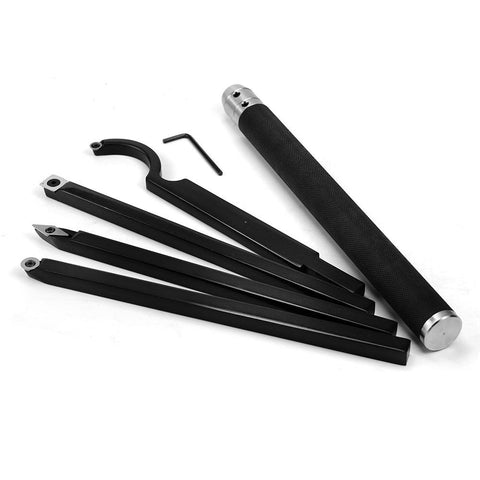Woodturning is an art that demands not only skill and precision but also the right set of tools to achieve the best possible results. Among the various types of tools available to woodturners, carbide-tipped tools have gained significant popularity due to their durability, sharpness, and ease of use. Carbide woodturning tools represent a significant leap forward from traditional high-carbon steel tools, offering woodturners a unique advantage in terms of cutting performance and longevity. These tools are designed to tackle a variety of turning projects, from intricate details on pens and spindles to the larger, more demanding tasks of bowl turning and hollowing. For both professional woodturners and hobbyists, investing in the best carbide woodturning tools can significantly enhance both the quality and efficiency of their craft.
One of the key advantages of carbide-tipped woodturning tools is their superior durability. Unlike traditional steel tools, carbide is much harder and more wear-resistant, which means that carbide tips can maintain their sharpness for longer periods. This is particularly important for woodturners who work on larger projects or with tougher woods, where frequent sharpening of steel tools can become time-consuming and tedious. Carbide tools eliminate the need for constant sharpening, allowing woodturners to focus on their projects without interruption. This longevity also translates into cost savings over time, as carbide tools require less frequent replacement compared to their steel counterparts.
Another significant benefit of carbide woodturning tools is their ability to produce smoother cuts with less effort. The sharpness of carbide tips allows for cleaner, more precise cuts, reducing the risk of tear-out, chatter, or uneven finishes. Whether turning softwoods or hardwoods, carbide tools are capable of producing high-quality results with minimal pressure, leading to smoother finishes right off the lathe. This is particularly important for woodturners who are working on fine details, such as the delicate curves of a bowl or the intricate patterns of a spindle. The reduced friction of carbide tools also means less heat is generated during the turning process, further preserving the wood's integrity and ensuring a cleaner result.
Carbide tools are also known for their versatility. Available in a range of profiles, from roughing gouges to detail tools, they can handle a wide variety of turning techniques. Many carbide tools feature replaceable inserts, which allow woodturners to switch out worn tips without having to invest in an entirely new tool. This is especially beneficial for those who turn a variety of projects and require different cutting profiles or tools for each job. The ability to easily replace inserts makes carbide tools highly adaptable, providing woodturners with a tool that can evolve to meet their needs over time.
In addition to their durability and versatility, carbide woodturning tools are also easier to use, particularly for beginners. Traditional steel tools often require a fair amount of skill and experience to properly sharpen and maintain. Carbide tools, on the other hand, require less attention to detail in terms of sharpening. Since the carbide tips stay sharp for longer periods, novice woodturners can spend more time turning and less time worrying about the maintenance of their tools. For beginners, this means a more enjoyable learning experience, where the focus is on technique and creativity, rather than on tool upkeep.
One of the most popular carbide tools among woodturners is the carbide insert tool, which features a round carbide insert that can be rotated to expose a fresh cutting edge as the tool wears. These tools are especially useful for turning larger pieces, as the insert can be rotated multiple times, providing a long-lasting edge without the need for frequent sharpening. Another highly regarded carbide tool is the carbide square tool, which is ideal for producing clean, sharp edges on projects like spindles or box lids. The square edge provides a flat surface that allows for precise cuts, while the carbide tip ensures longevity and smoothness.
While carbide tools are easier to maintain, they still require proper handling and care. Woodturners should ensure that their tools are securely mounted in the tool rest and that they are held at the correct angle for the project at hand. In addition, it's important to use the right technique when turning with carbide tools to maximize their efficiency and ensure safety. For example, when roughing down a large bowl, a woodturner might use a carbide roughing tool to remove material quickly, while finer detail tools are used to shape and finish the piece. This combination of carbide tools enables woodturners to take advantage of the unique benefits of each tool while achieving the best possible result.
Carbide woodturning tools are available in various sizes, shapes, and designs, allowing woodturners to select the perfect tool for their specific needs. Some tools come with ergonomic handles for added comfort during long turning sessions, while others are designed for precision work and detailed carving. For those looking to achieve professional results, there are even specialized carbide tools designed specifically for hollowing, texturing, or sanding.
In conclusion, the best carbide woodturning tools offer a perfect combination of durability, sharpness, and ease of use, making them an excellent choice for woodturners of all skill levels. Whether you are a beginner looking for a low-maintenance tool or a seasoned professional in need of precision and efficiency, carbide tools can help elevate your craft to the next level. With their long-lasting edges, smooth cutting performance, and versatility across different materials, carbide woodturning tools are a wise investment for anyone serious about producing high-quality, beautiful woodturned pieces.
